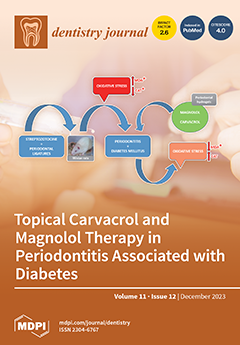In this study, we examined the cytotoxic effects of six commercial children’s mouthrinses (designated as #1, #2, #3, #4, #5, and #6) and four commercial children’s toothpastes (designated as #1, #2, #3, and #4) on primary human neonatal melanocytes that were used as
[...] Read more.
In this study, we examined the cytotoxic effects of six commercial children’s mouthrinses (designated as #1, #2, #3, #4, #5, and #6) and four commercial children’s toothpastes (designated as #1, #2, #3, and #4) on primary human neonatal melanocytes that were used as a representative model for oral melanocytes. Mouthrinses diluted directly with culture medium (1:2, 1:5, 1:10, 1:100, and 1:1000) were added to monolayers of melanocytes for 2 min, followed by 24 h recovery, after which MTS cytotoxicity assay was conducted. The extracts of each toothpaste were prepared (50%
w/
v), diluted in culture medium (1:2, 1:5, 1:10, 1:50, 1:100, and 1:1000), and added to cell monolayers for 2 min (standard brushing time), followed by an analysis of cell viability after 24 h. Results showed that all mouthrinses except mouthrinse #4 showed significantly greater loss of cell viability, ascribed to cetylpyridinium chloride (CPC) that induced significant cytotoxicity to melanocytes (IC
50 = 54.33 µM). In the case of toothpastes, the examination of cellular morphology showed that a 2 min exposure to all toothpaste extracts induced a concentration-dependent decline in cell viability, pronounced in toothpaste containing sodium lauryl sulfate (SLS) detergent. Further results suggested SLS to be the critical driver of cytotoxicity (IC
50 = 317.73 µM). It is noteworthy that toothpaste #1 exhibited much lower levels of cytotoxicity compared to the other three toothpastes containing SLS. Taken together, these findings suggest that the melanocytotoxicity of children’s mouthrinse (#4) and toothpaste (#1) is comparatively low. To the best of our knowledge, this is the first study to examine the impact of children’s toothpastes and mouthrinses on neonatal primary human melanocytes. Future studies to investigate these findings in a realistic scenario replicating oral cavity conditions of the presence of microbiota, pellicle layer and saliva, and other cell types are warranted.
Full article






